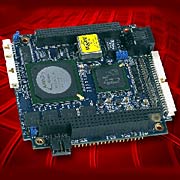
|
contents | hardware | |||||||
| VersaLogic's New RoHS PC/104-Plus Single Board Computer  VersaLogic Corp. has announced a new embedded computer in its line of PC/104-Plus products. The new "Puma" board features a reliable design and very low power draw (less than 5W total). Puma is fanless with no moving parts, and is offered in both standard temperature (0° C to +60° C) and extended temperature (- 40° C to +85° C) versions. This board is targeted at medical, avionics, and security/homeland defense markets. It is especially suited for embedded control applications requiring a very small footprint, which the 3.6" x 3.8" board provides. The Puma includes a Windows-compatible suspend-to-RAM power management system that reduces power draw to less than 900 milliwatts during standby. The power management system is invaluable to applications where power is at a premium, such as portable devices and transportation systems, as well as applications in remote locations where available power is a concern. VersaLogic Corp. has announced a new embedded computer in its line of PC/104-Plus products. The new "Puma" board features a reliable design and very low power draw (less than 5W total). Puma is fanless with no moving parts, and is offered in both standard temperature (0° C to +60° C) and extended temperature (- 40° C to +85° C) versions. This board is targeted at medical, avionics, and security/homeland defense markets. It is especially suited for embedded control applications requiring a very small footprint, which the 3.6" x 3.8" board provides. The Puma includes a Windows-compatible suspend-to-RAM power management system that reduces power draw to less than 900 milliwatts during standby. The power management system is invaluable to applications where power is at a premium, such as portable devices and transportation systems, as well as applications in remote locations where available power is a concern.Puma is a fully RoHS-compliant product designed to meet Advertisement EU Directive 2002/95/EC. This is VersaLogic's second RoHS-compliant embedded computer release. The Puma board features the AMD GX 500 processor. Standard on-board features include 256 MB soldered-on SDRAM, 3 COM ports, 4 USB 2.0 ports, Ethernet, IDE, LPT, audio I/O, and keyboard/mouse/floppy support via USB ports. The board also includes integrated SVGA video with LVDS flat-panel support. The PC/104-Plus interface supports both ISA and PCI add-on modules. Standard pass-through connectors allow the board to be used either above or below other PC/104 modules. It may also be used as a CPU module for larger system, by plugging it into a proprietary base board that includes specific user I/O circuitry. As with other VersaLogic embedded computer boards, the Puma includes a customizable, OEM-enhanced BIOS that is field-upgradeable. It is designed to work with embedded operating systems, including Windows CE/XP/XPe, Linux, VxWorks, QNX, DOS, and other real-time OSs. write your comments about the article :: © 2006 Computing News :: home page |